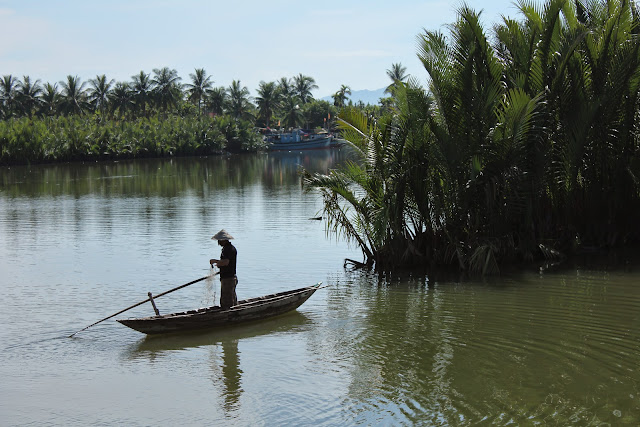By Mpom
I finally met someone who spoke English at my most frequented Hoi An culinary hotspot: the local market on the road to Cua Dai beach. Trinh, donning a mandarin satin uniform from her hotel shift, informed me I was eating banh bot loc, bite-size clear rice noodle pockets of shrimp and potato lathered in oily chili-garlic fishsauce and sprinkled with chives. She also equipped me with a number of useful phrases.
The next day, lathered in sweatproof 50 spf, I am prepared for a day of cycling Hoian with my Canon camera, large water bottle, and Vietnamese “hello” “what is this” “how much” “thank you” “what is your name.” Anxious to escape the countless tailor shops and chorus of Vietnamese-accented “hellos” ringing with the single-minded pursuit of cash, I peddle off toward the Cam Thanh fishing village. Past rice fields, their moist, sweet smell overtaking the toxic exhaust of whirring motorbikes. Past dry fields sprouting solitary concrete shrines, miniature marigold-painted, red-roofed temples perched on posts and filled with the incense remains of prayers past. Past a wedding reception, punchy Vietnamese hip-hop and raucous laughter spilling through the gauzy red and pink decorations onto dusty streets. Past tightly packed teams of bamboo trees standing in shallow water dotted with wooden canoes; the owners shade their faces with conical hats fashioned from tan, slender leaves as they pull clear fishing lines from the water without end, like magic trick ribbons from a spectator’s ear.
I happen upon a small farmers’ protest in a town clearly surviving on the bamboo leaf industry, open-air sheds filled with drying stacks. Ten old men and women, skin shriveled brown and their few surviving teeth like cracked and blackened bits of corn, quack poorly coordinated group chants. They clank sticks on hollow bamboo poles, shouting as police in olive uniforms half-heartedly herd the farmers’ bare feet down the town’s one cement road. A few meters later, I discover two young men who accept my hand gesture request to watch them as they make bamboo siding. Around the corner and four thousand dong ($2) later, an eager woman, clearly awaiting any lost tourists who happen upon her home, paddles me amongst the bamboo forest, the easy-going whoosh of her paddle gliding us through narrow water alleyways winding amongst the trees.
After many thanks and photos, I decide to take a coffee break on the riverbank. As small restaurants and cafes are merely extensions of the family living room, I join an extended family as its three women make sugar cane juice and skin bamboo shoots while four men of various generations drink their 10 am beer and idle in hammocks. It is a dirt road town with few diversions beyond its natural beauty; I quickly become easy entertainment. An entire wedding party arrives and sheepishly indicates they would like a photo shoot with the disheveled American biker. (They are one of the 13 wedding parties I will see July 17; I find out over my dinner noodles that it is an auspicious day for weddings amongst the Buddhists in the area). We snap approximately twenty-three group photos and a series of individual shots, me in a sweat-darkened grey t-shirt, the men in their suits, and the party’s primped and whitened women in brightly colored and sequined ao dai, high-neck long-sleeved tops that fall to their knees slits up the thigh showing matching loose pants. (I love when enthusiastic, camera-happy groups attack me; it redeems me and gives me good travel photography karma.) Like confetti, the giggling party blows on down the street.
Seeing the fun has passed, a sinewy old man, one of the four boozers slouched in the hammocks, begins crafting bamboo leaf glasses so he can swap me for my black plastic frames. The family collapses in jovial howls. We start our own photo session using my camera. Then my coffee is finally finished. I wave and proceed to peddle around the area for another six hours before returning to my hostel near the Old City.
A few custom-made shoes and sandals, one more night in my slanted-ceiling, and a relaxing day at the beach later, I board an overnight sleeper bus to Nha Trang en route to the mountain town of Dalat, famous for its flowers and honeymooners. Away goes the swimsuit, out comes the jacket. Fast-forward two days: I am riding on the back of Vietnamese Khein’s motorcycle on the winding roads beyond Dalat, poncho flapping around my body. I take in the chilly hillside. It is a scene from my childhood: a Kansas patchwork quilt of fields, but here stretched over the rolling land and sprinkled with trees.
And this is what I love most about traveling: passing—biking, walking, hitching, swimming, busing—through people’s day-to-day routines. Rumbling along on the back of the cycle, I am seeing the 6 pm near Dalat. I can imagine the 6 pm Hoi An market with its faithful food stall vendors, perhaps wondering where the odd solo American girl has gone after nine meals in their company. Or maybe the absence goes completely unnoticed. In New York, I can see my friends on subways headed home from work. In Kansas, Mom is driving home about to feed the horses. For now, in biking Hoian, I am passing through these realities, like a person entering a dance after it has begun, enjoying the beat while it is in full swing, and then gracefully bowing out before the music has a chance to trail off. It is the ability to enjoy each local’s unappreciated routines as if fabulous novelties. Traveling through these varied alternatives is the should-tap-whisper-in-the-ear that the reality of one place simultaneously exists amongst a million others, including the place I call home. And how quickly, when I once again begin to make my circles in that home place, my reality will misguidedly become the world.







0 comments:
Post a Comment